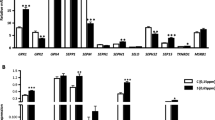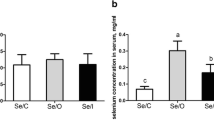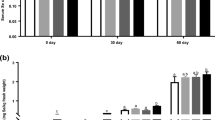Abstract
The trace element selenium (Se) plays a key role in development and various physiological processes, mainly through its transformation into selenoproteins. To investigate the developmental patterns of Se content and expression of selenoproteins, the liver and longissimus dorsi (LD) muscle of Duroc pigs were collected at 1, 21, 80, and 185 days of age (7 pigs each age) for the determination of Se content, mRNA expression of selenoproteins, and concentrations of glutathione peroxidase (GPX), thioredoxin reductase (TrxR or TXNRD), and selenoprotein P (SELP). The results showed that age significantly affected the expression of GPX1, GPX2, GPX3, TXNRD1, TXNRD2, TXNRD3, iodothyronine deiodinases 2 (DIO2), DIO3, SELF, SELH, SELM, SELP, SELS, SELW, and selenophosphate synthetase2 (SPS2) in the liver, as well as GPX3, GPX4, TXNRD1, TXNRD2, DIO2, DIO3, SELF, SELN, SELP, SELR, SELS, and SELW in the LD muscle of Duroc pigs. The concentrations of GPX, TrxR, and SELP showed an increasing trend with age, and they were positively correlated with Se content at 1, 21, and 185 days of age and negatively correlated at 80 days of age, both in the liver and LD muscle. The Se content decreased at the age of 80 days, especially in the LD muscle. In summary, our study revealed developmental changes in Se content and expression of selenoproteins in the liver and LD muscle of Duroc pigs at different growth stages, which provided a theoretical basis for further study of Se nutrition and functions of selenoproteins.





Similar content being viewed by others
Data Availability
The data presented in the study are included in the article. Further inquiries can be directed to the corresponding authors.
References
Rayman MP (2012) Selenium and human health. Lancet 379(9822):1256–1268. https://doi.org/10.1016/S0140-6736(11)61452-9
Roman M, Jitaru P, Barbante C (2014) Selenium biochemistry and its role for human health. Metallomics 6(1):25–54. https://doi.org/10.1039/c3mt00185g
Pappa EC, Pappas AC, Surai PF (2006) Selenium content in selected foods from the Greek market and estimation of the daily intake. Sci Total Environ 372(1):100–108. https://doi.org/10.1016/j.scitotenv.2006.08.008
Burk RF, Hill KE (2009) Selenoprotein P-expression, functions, and roles in mammals. Biochim Biophys Acta 1790(11):1441–1447. https://doi.org/10.1016/j.bbagen.2009.03.026
Alehagen U, Opstad TB, Alexander J, Larsson A, Aaseth J (2021) Impact of selenium on biomarkers and clinical aspects related to ageing. A review. Biomolecules 11(10) https://doi.org/10.3390/biom11101478
Weeks BS, Hanna MS, Cooperstein D (2012) Dietary selenium and selenoprotein function. Med Sci Monit 18(8):RA127–132. https://doi.org/10.12659/msm.883258
Burk RF, Hill KE (2015) Regulation of selenium metabolism and transport. Annu Rev Nutr 35:109–134. https://doi.org/10.1146/annurev-nutr-071714-034250
Hariharan S, Dharmaraj S (2020) Selenium and selenoproteins: it’s role in regulation of inflammation. Inflammopharmacology 28(3):667–695. https://doi.org/10.1007/s10787-020-00690-x
Zhang W, Yin K, Shi J, Shi X, Qi X, Lin H (2022) The decrease of selenoprotein K induced by selenium deficiency in diet improves apoptosis and cell progression block in chicken liver via the PTEN/PI3K/AKT pathway. Free Radic Biol Med 189:20–31. https://doi.org/10.1016/j.freeradbiomed.2022.07.005
Yu J, Zhao P, Zheng X, Zhou L, Wang C, Liu JF (2020) Genome-wide detection of selection signatures in duroc revealed candidate genes relating to growth and meat quality. G3 (Bethesda) 10(10):3765–3773. https://doi.org/10.1534/g3.120.401628
Zhou X, Liu Y, Xiong X, Chen J, Tang W, He L, Zhang Z, Yin Y, Li F (2022) Intestinal accumulation of microbiota-produced succinate caused by loss of microRNAs leads to diarrhea in weanling piglets. Gut Microbes 14(1):2091369. https://doi.org/10.1080/19490976.2022.2091369
He Y, Liu Y, Guan P, He L, Zhou X (2022) Serine administration improves selenium status, oxidative stress, and mitochondrial function in longissimus dorsi muscle of piglets with intrauterine growth retardation. Biol Trace Elem Res. https://doi.org/10.1007/s12011-022-03304-5
Gao M, Yang N, Lei Y, Zhang W, Liu H, Lin H (2022) Tannic acid antagonizes atrazine exposure-induced autophagy and DNA damage crosstalk in grass carp hepatocytes via NO/iNOS/NF-kappaB signaling pathway to maintain stable immune function. Fish Shellfish Immunol 131:1075–1084. https://doi.org/10.1016/j.fsi.2022.11.024
Long J, Liu Y, Zhou X, He L (2021) Dietary serine supplementation regulates selenoprotein transcription and selenoenzyme activity in pigs. Biol Trace Elem Res 199(1):148–153. https://doi.org/10.1007/s12011-020-02117-8
Zhou L, Feng Y, Liu Y, He L, Zhou X, Yin Y (2022) Serine supplementation in the diets of late gestating and lactating sows improves selenium nutritional status in sows and their offspring. Biol Trace Elem Res 200(2):609–614. https://doi.org/10.1007/s12011-021-02661-x
Avery JC, Hoffmann PR (2018) Selenium, selenoproteins, and immunity. Nutrients 10(9) https://doi.org/10.3390/nu10091203
Lu Z, Wang P, Teng T, Shi B, Shan A, Lei XG (2019) Effects of dietary selenium deficiency or excess on selenoprotein gene expression in the spleen tissue of pigs. animals (basel) 9(12) https://doi.org/10.3390/ani9121122
Schomburg L, Riese C, Renko K, Schweizer U (2007) Effect of age on sexually dimorphic selenoprotein expression in mice. Biol Chem 388(10):1035–1041. https://doi.org/10.1515/BC.2007.128
Barchielli G, Capperucci A, Tanini D (2022) The role of selenium in pathologies: an updated review. antioxidants (basel) 11(2) https://doi.org/10.3390/antiox11020251
Lu J, Holmgren A (2014) The thioredoxin antioxidant system. Free Radic Biol Med 66:75–87. https://doi.org/10.1016/j.freeradbiomed.2013.07.036
He Y, Liu Y, Tang J, Jia G, Liu G, Tian G, Chen X, Cai J, Kang B, Zhao H (2022) Selenium exerts protective effects against heat stress-induced barrier disruption and inflammation response in jejunum of growing pigs. J Sci Food Agric 102(2):496–504. https://doi.org/10.1002/jsfa.11377
Liu Y, Beyer A, Aebersold R (2016) On the dependency of cellular protein levels on mRNA abundance. Cell 165(3):535–550. https://doi.org/10.1016/j.cell.2016.03.014
Sauro HM (2017) Control and regulation of pathways via negative feedback. J R Soc Interface 14(127) https://doi.org/10.1098/rsif.2016.0848
Ambrosio R, De Stefano MA, Di Girolamo D, Salvatore D (2017) Thyroid hormone signaling and deiodinase actions in muscle stem/progenitor cells. Mol Cell Endocrinol 459:79–83. https://doi.org/10.1016/j.mce.2017.06.014
Pascual A (1830) Aranda A (2013) Thyroid hormone receptors, cell growth and differentiation. Biochim Biophys Acta 7:3908–3916. https://doi.org/10.1016/j.bbagen.2012.03.012
Dentice M, Marsili A, Ambrosio R, Guardiola O, Sibilio A, Paik JH, Minchiotti G, DePinho RA, Fenzi G, Larsen PR, Salvatore D (2010) The FoxO3/type 2 deiodinase pathway is required for normal mouse myogenesis and muscle regeneration. J Clin Invest 120(11):4021–4030. https://doi.org/10.1172/JCI43670
Sosic-Jurjevic B, Lutjohann D, Jaric I, Miler M, Vojnovic Milutinovic D, Filipovic B, Ajdzanovic V, Renko K, Wirth EK, Jankovic S, Kӧhrle J, Milosevic V (2017) Effects of age and soybean isoflavones on hepatic cholesterol metabolism and thyroid hormone availability in acyclic female rats. Exp Gerontol 92:74–81. https://doi.org/10.1016/j.exger.2017.03.016
Kohrle J, Fradrich C (2022) Deiodinases control local cellular and systemic thyroid hormone availability. Free Radic Biol Med 193(Pt 1):59–79. https://doi.org/10.1016/j.freeradbiomed.2022.09.024
Schomburg L (2022) Selenoprotein P - Selenium transport protein, enzyme and biomarker of selenium status. Free Radic Biol Med 191:150–163. https://doi.org/10.1016/j.freeradbiomed.2022.08.022
Sherlock LG, Sjostrom K, Sian L, Delaney C, Tipple TE, Krebs NF, Nozik-Grayck E, Wright CJ (2020) Hepatic-specific decrease in the expression of selenoenzymes and factors essential for selenium processing after endotoxemia. Front Immunol 11:595282. https://doi.org/10.3389/fimmu.2020.595282
Castets P, Lescure A, Guicheney P, Allamand V (2012) Selenoprotein N in skeletal muscle: from diseases to function. J Mol Med (Berl) 90(10):1095–1107. https://doi.org/10.1007/s00109-012-0896-x
Whanger PD (2009) Selenoprotein expression and function-selenoprotein W. Biochim Biophys Acta 1790(11):1448–1452. https://doi.org/10.1016/j.bbagen.2009.05.010
Petit N, Lescure A, Rederstorff M, Krol A, Moghadaszadeh B, Wewer UM, Guicheney P (2003) Selenoprotein N: an endoplasmic reticulum glycoprotein with an early developmental expression pattern. Hum Mol Genet 12(9):1045–1053. https://doi.org/10.1093/hmg/ddg115
Zhou X, Liu Y, Zhang L, Kong X, Li F (2021) Serine-to-glycine ratios in low-protein diets regulate intramuscular fat by affecting lipid metabolism and myofiber type transition in the skeletal muscle of growing-finishing pigs. Anim Nutr 7(2):384–392. https://doi.org/10.1016/j.aninu.2020.08.011
Brennan KM, Terry EN, Michal JJ, Kincaid RL, Johnson KA (2009) Body weight loss in beef cows: II. Increased antioxidant messenger ribonucleic acid levels in skeletal muscle but not erythrocyte antioxidant activity. J Anim Sci 87(9):2867–73 https://doi.org/10.2527/jas.2008-1301
Kil DY, Kim BG, Stein HH (2013) Feed energy evaluation for growing pigs. Asian-Australas J Anim Sci 26(9):1205–1217. https://doi.org/10.5713/ajas.2013.r.02
Surai PF, Kochish, II, Fisinin VI, Juniper DT (2019) Revisiting oxidative stress and the use of organic selenium in dairy cow nutrition. Animals (Basel) 9(7) https://doi.org/10.3390/ani9070462
Funding
This work was jointly supported by the Key Project of Regional Innovation and Development Joint Fund of National Natural Science Foundation of China (U20A2056) and National Students’ Platform for Innovation and Entrepreneurship Training Program (202210542036).
Author information
Authors and Affiliations
Contributions
Yiwen He, Peng Guan, and Yan Zeng conceived and designed the experiments; Can Peng participated in the final interpretation of the data; Yiwen He, Peng Guan, Yan Zeng, and Le Huang acquired and analyzed the data; Yiwen He, Peng Guan, and Yan Zeng drafted the manuscript. Xihong Zhou and Xiangfeng Kong supervised the whole experiment and reviewed the manuscript. All the authors read and approved the final manuscript.
Corresponding authors
Ethics declarations
Ethics Approval
The study was conducted according to the principles of the Animal Care Committee of the Institute of Subtropical Agriculture, Chinese Academy of Sciences and was approved by the animal welfare committee of the Institute of Subtropical Agriculture, Chinese Academy of Sciences (Approval no. 20200018).
Consent to Participate
Not applicable.
Consent for Publication
Not applicable.
Competing Interests
The authors declare no competing interests.
Additional information
Publisher's Note
Springer Nature remains neutral with regard to jurisdictional claims in published maps and institutional affiliations.
Supplementary Information
Below is the link to the electronic supplementary material.
Rights and permissions
Springer Nature or its licensor (e.g. a society or other partner) holds exclusive rights to this article under a publishing agreement with the author(s) or other rightsholder(s); author self-archiving of the accepted manuscript version of this article is solely governed by the terms of such publishing agreement and applicable law.
About this article
Cite this article
He, Y., Guan, P., Zeng, Y. et al. Age-Dependent Developmental Changes of Selenium Content and Selenoprotein Expression and Content in Longissimus Dorsi Muscle and Liver of Duroc Pigs. Biol Trace Elem Res 202, 182–189 (2024). https://doi.org/10.1007/s12011-023-03674-4
Received:
Accepted:
Published:
Issue Date:
DOI: https://doi.org/10.1007/s12011-023-03674-4




